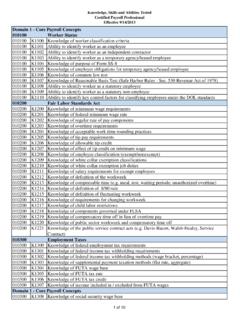Transcription of NCCMP Annual Conference Saturday, September 22, 2018
1 Appropriateness of Current Assumptions NCCMP Annual Conference Saturday, September 22, 2018. Jason Russell, FSA, MAAA, EA. Senior Vice President and Actuary The opinions expressed in this presentation are those of the presenter and do not necessarily represent the views of the Segal Group or the National Coordinating Committee for Multiemployer Plans. Copyright 2018 by The Segal Group, Inc. All rights reserved. Discussion Topics Introduction and Brief History Statutory and Professional Requirements Evaluating the Investment Return Assumption Multiemployer Universe: Then and Now Segal Data Publication 1. Introduction and a Brief History 2. Introduction Interest rate assumption Discount rate used to determine present value of benefit obligations Traditionally represents expected return on plan assets Alternatively, may be a market-based, risk-defeasement measure Current funding rules Single-employer pension plans Required to use assumption based on corporate bond rates Special relief measures allow 25-year interest rate smoothing Effective interest rate for most plans is around (with smoothing).
2 Multiemployer pension plans Assumption is actuary's best estimate of future plan experience Most plans have interest rates between and 3. Multiemployer Pension Universe The size of each bubble corresponds to the number of total participants in each plan. 4. Zone Status by Industry Plans All Industries Construction Service Retail/Food Transportation Manufacturing Entertainment Total Plans 1,242 Plans 758 Plans 94 Plans 67 Plans 173 Plans 102 Plans 48 Plans Green Zone 62% 66% 71% 48% 53% 43% 71%. Endangered 12% 14% 4% 10% 10% 6% 17%. Critical 16% 16% 19% 31% 17% 14% 6%. Declining 10% 4% 5% 10% 20% 37% 6%. Participants All Industries Construction Service Retail/Food Transportation Manufacturing Entertainment Total Participants Million Million Million Million Million Million Million Green Zone 56% 64% 56% 47% 52% 42% 81%.
3 Endangered 12% 25% 1% 4% 6% 1% 5%. Critical 20% 11% 41% 41% 5% 5% 13%. Declining 12% 1% 2% 9% 36% 52% 0%. Percentages may not add, due to rounding. For simplicity, certain industries and trades are grouped as follows: - Transportation includes truck ing and freight, warehouse work ers, bak ery drivers, and maritime - Manufacturing includes bak ery work ers, printing, energy, mining, and agriculture - Service includes hospitality, healthcare, education, and communications Source: Segal Consulting analysis of Form 5500 data for plan years ending in 2016. Zone status applies to plan years ending in 2017. 5. A Brief History Pre- erisa . No federal funding standards Studebaker bankruptcy in 1964 major default on pension promises Passage of erisa .
4 erisa = employee retirement income security Act of 1974. Anti-cutback rule: accrued benefit protections Minimum funding standards Funding standard account targets 100% funding over 15-20 years Based on long-term actuarial assumptions PBGC established to support insolvent plans 6. A Brief History Continued 1980s Strong investment returns Market interest rates in double digits Actuarial interest rate assumptions gradually increased In 1980, most actuaries used assumptions around Scrutiny over assumptions being too conservative Lower interest rates = higher plan liabilities = greater tax-deductions By mid 1980s, most assumptions were raised to between and 1990s Continued strong investment returns Most private sector plans were close to full-funding, some were over-funded IRS rules limited tax-deductibility of employer contributions to fully-funded plans Many corporate plan sponsors took contribution holidays.
5 Many multiemployer plan sponsors increased benefits to preserve tax- deductibility of previously-negotiated employer contributions 7. A Brief History Continued Passage of PPA. Dot-Com Bubble Burst from 2000 to 2002. Plan sponsors scrambled to restore plan funding levels Notable corporate bankruptcies, plans turned over to PBGC. Corporations began to close, freeze their DB plans PPA = Pension Protection Act of 2006. Overhaul of funding rules for single-employer plans Mandated actuarial assumptions, shorter funding periods Increased trend for freezing DB plans Modifications to funding rules for multiemployer plans Continue using long-term actuarial assumptions Limit amortization periods to 15 years Additional rules for plans in critical or endangered status Critical status plans may reduce adjustable benefits.
6 Critical status plans may also declare exhaustion of reasonable measures . 8. A Brief History Continued Post-PPA. Financial market collapse of 2008 and early 2009. Interest rates fell to historic lows Declining work levels following Great Recession Multiemployer plans: Median investment return for 2008 = about -23%. Plan sponsors developed plans to restore funding under new PPA rules Significant increases in contribution rates, reductions in benefit levels Most succeeded in improving funding levels, others did not Passage of MPRA. MPRA= Multiemployer Pension Reform Act of 2014. Additional tools to enable plans in critical and declining to avoid insolvency Benefit suspensions ( , reduction in accrued benefits, subject to limitations).
7 PBGC partitions (subject to PBGC available resources). PBGC facilitated mergers (subject to PBGC available resources). 9. Historical Investment Returns Historical Multiemployer Plan Returns Rolling 10-Year Rolling 20-Year Rolling 30-Year 10-Year Teasury Yield Benchmark Benchmark Benchmark 15%. 14% 1989, 13%. 1999, 12%. 11%. 10%. 9%. 8%. 7%. 6%. 5%. 4%. 3%. 2% 2009, Source for Annual Multiemployer Plan 1% Returns: Segal Marco Advisors 0%. 1980. 1981. 1982. 1983. 1984. 1985. 1986. 1987. 1988. 1989. 1990. 1991. 1992. 1993. 1994. 1995. 1996. 1997. 1998. 1999. 2000. 2001. 2002. 2003. 2004. 2005. 2006. 2007. 2008. 2009. 2010. 2011. 2012. 2013. 2014. 2015. 2016. 2017. Rolling 30-year returns have been consistently above benchmark Rolling 10-year returns for 1980s, 1990s, and 2000s highlighted for reference Note: annualized 8-year return from 2010-2017 is 10.
8 Statutory and Professional Requirements 11. Actuarial Assumptions under PPA. Excerpt: erisa Section 304(c) / Code Section 432(c). (3) Actuarial assumptions must be reasonable For purposes of this section, all costs, liabilities, rates of interest, and other factors under the plan shall be determined on the basis of actuarial assumptions and methods . (A) each of which is reasonable (taking into account the experience of the plan and reasonable expectations), and (B) which, in combination, offer the actuary's best estimate of anticipated experience under the plan. Note: Provisions amended by the Pension Protection Act of 2006. 12. Actuarial Standards of Practice No. 27. ASOP No. 27 = Selection of Economic Assumptions for Measuring Pension Obligations General Selecting a reasonable assumption Appropriate for purpose of the measurement Reflects the actuary's professional judgment Takes into account relevant historical and current economic data Reflects actuary's estimate of future experience (or estimates in market data).
9 Has no significant bias Range of reasonable assumptions Actuaries may choose different reasonable assumptions Individual actuary may have a range of reasonable assumptions Range of reasonable assumptions may also apply across actuarial practice Adjustment for adverse deviation may be appropriate 13. Actuarial Standards of Practice No. 27 Continued Selecting an Investment Return Assumption Reflects anticipated returns on plan assets May consider economic data and judgment of investment professionals Avoid undue weight to recent experience Consider changes in underlying environment when evaluating historical data Factors to consider: time value of money inflation, inflation risk illiquidity credit risk macroeconomic conditions growth in earnings, dividends, and rents Investment data may include: current fixed income yields inflation forecasts, GDP growth historical investment and yield data historical plan performance Measurement-specific considerations.
10 Plan's investment policy effect of reinvestment investment volatility investment manager performance investment and administrative expenses cash flow timing benefit volatility expected plan termination tax status arithmetic vs. geometric returns 14. Investment Return Assumptions under MPRA. Excerpt: Proposed Treasury Regulations (June 2015). Reasonable actuarial assumptions and methods. The actuarial assumptions and methods used for the actuarial projections must be reasonable, in accordance with the rules of section 431(c)(3).. Excerpts: Final Treasury Regulations (April 2016). actuarial assumptions must be reasonable for the purpose of the measurement (under the applicable ASOPs).


